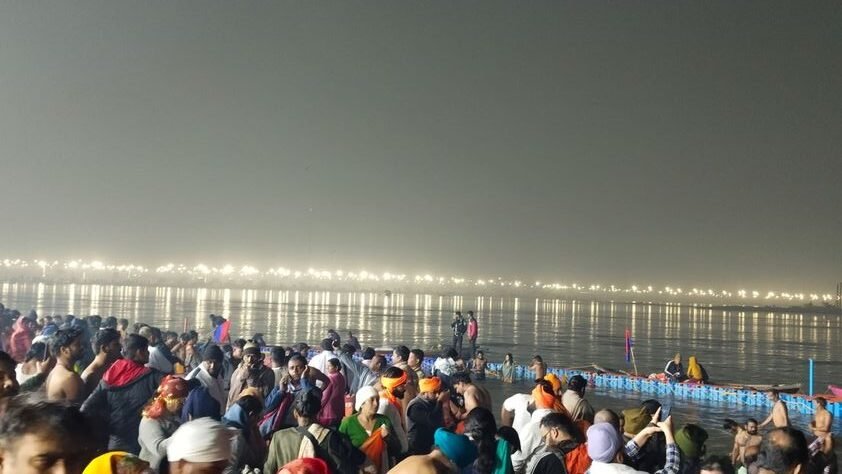Mahakumbh 2025: My Journey Review

The journey of over 650 kilometers started at 8:20 PM on Friday, February 7, 2025. Spirits were high, and the excitement was palpable. The thought of witnessing one of the grandest religious gatherings in the world, Mahakumbh, added a sense of thrill to the trip. However, what seemed like an exhilarating adventure soon turned into a trial of patience, endurance, and sheer willpower.
The Journey Begins: A Road Full of Anticipation
As we set out on our journey, the roads were alive with thousands of travelers heading toward the sacred site. It felt less like a regular drive and more like being part of a grand procession. Vehicles of all kinds filled the highways, creating an atmosphere similar to a roadshow of a high-profile politician. The energy was electrifying, with chants of devotion and excitement filling the air.
But as night turned into the early hours of the morning, reality started to set in. The smooth drive of the first 500 kilometers, which took around nine hours, seemed like a dream compared to what followed. The last 150 kilometers became an endurance test, dragging on for an excruciating 18 hours. Traffic jams were endless, leaving vehicles at a standstill for hours at a time. Horns blared incessantly, yet there was no way forward. It seemed as if time had stopped, and patience became our only refuge.
Chaos at the Roadside Stops
Along the way, we stopped at various roadside dhabas and hotels for refreshments. The scene there was nothing short of mayhem. People jumped for food as if it were their last meal, and some places ran out of food entirely. Long queues formed at every eatery, with no certainty of getting a meal even after hours of waiting. Price gouging was rampant, with vendors charging double for tasteless food that barely satisfied hunger.
Public washrooms were another nightmare. Petrol pumps, hotels, and any other possible rest stops had their restrooms reduced to unhygienic pits of filth. The sheer disregard for cleanliness was disheartening. Despite numerous toilets built near the ghats, parking lots, and public areas, people still chose to relieve themselves wherever they pleased, adding to the growing sanitation crisis.
The Last Stretch: Desperation and Opportunism
The last 150 kilometers of the journey tested our patience beyond limits. Every traveler was desperate to reach the destination. Opportunists seized the moment—bikers charged 1,000 INR per head to ferry people a mere kilometers, while roadside vendors hiked prices to exorbitant levels for even the most basic commodities. The desperation in people’s eyes was evident, but there was little choice. Some walked for miles, some clung to overloaded vehicles, while others bargained for a way forward.
It was a reminder that no matter how much we plan, fate has its way of teaching lessons. The road to Mahakumbh became a metaphor for life’s journey—unpredictable, filled with struggles, yet ultimately rewarding.
The Magnificence of Mahakumbh
After the harrowing journey, stepping into the Mahakumbh premises felt surreal. Mahakumbh is not just an event; it is a grand spectacle of faith, devotion, and tradition that unfolds once every 144 years, making it the rarest and most significant of all Kumbh gatherings. This celestial confluence of spirituality attracts millions, including saints, seers, and devotees, all drawn by the promise of divine blessings and purification.
The origins of Mahakumbh trace back to the mythological Samudra Manthan—the great churning of the ocean—where gods and demons fought over a divine pitcher (Kumbh) containing the nectar of immortality. As the struggle ensued, drops of the nectar fell at four sacred locations—Prayagraj, Haridwar, Ujjain, and Nashik. These sites now host the Kumbh Mela at different intervals, but the Mahakumbh in Prayagraj is the rarest, occurring once in nearly a century and a half. The 2025 Mahakumbh was expected to welcome over 400 million devotees, making it one of the largest religious gatherings in recorded history.
The Grand Spectacle at the Ghats
Reaching the banks of the sacred Sangam at midnight felt like stepping into a mystical realm, eerily silent yet alive with the presence of thousands. The confluence of the Ganga, Yamuna, and the mythical Saraswati shimmered under the moonlight, its waters reflecting the glow of countless lamps placed by devotees along the shore. The absence of the usual daylight fanfare—no loud chants, no temple bells, and no grand processions of Akharas—made the moment feel even more surreal.
Despite the late hour, the place was teeming with devotees. Thousands of people, wrapped in devotion and determination, were already immersed in the holy waters, performing their sacred rituals under the open sky. The cold air carried whispers of prayers and the occasional murmur of hymns as pilgrims took their ritualistic dips, believing that the waters of Sangam would cleanse them of sins and bring them closer to salvation.
In the darkness, flames of small oil lamps floating on the river created an enchanting sight, as if the stars had descended upon the waters. The quiet devotion of the midnight bathers, undisturbed by the grandiosity of daytime festivities, gave the moment a deeper, almost personal sense of spirituality. This was Mahakumbh at its purest—where faith did not need the presence of an audience, where the river itself seemed to embrace every soul seeking redemption.
The Challenges Within the Mela
Despite the spiritual magnificence, the crowd management posed severe challenges. Basic amenities were stretched to their limits. Makeshift tents provided shelter for thousands, yet many still slept under the open sky. Every corner had something to offer, from astrologers predicting futures to street vendors selling souvenirs. The aroma of food stalls offering hot tea and snacks filled the air, providing momentary relief to exhausted travelers.
Sanitation remained a pressing concern. While authorities had installed thousands of portable toilets and sanitation workers worked tirelessly, the sheer volume of visitors made it nearly impossible to maintain hygiene. Garbage disposal became a massive challenge, and some areas turned into trash piles, overshadowing the otherwise divine atmosphere.
The Lessons from the Journey
The Mahakumbh journey was more than just a pilgrimage; it was a life-altering experience. It taught the essence of patience, endurance, and adaptability. The hardships along the way mirrored the struggles of life, reinforcing the idea that no matter how insurmountable obstacles seem, perseverance leads to ultimate satisfaction.
People encountered on the journey were as diverse as India itself—some kind, some opportunistic, some struggling, and some simply enjoying the chaos. The journey emphasized that human nature, in its rawest form, emerges in testing situations. But amid all the hardship, the moment of taking the holy dip, surrounded by millions sharing the same faith, made every difficulty worth it.
The Final Moments: A Sense of Accomplishment
Leaving the Mahakumbh was bittersweet. The journey back home was equally exhausting, but the experience gained overshadowed all discomfort. The sense of accomplishment, the overwhelming spiritual energy, and the realization that faith can drive millions to endure any hardship left a lasting impression.
Mahakumbh 2025 was not just about religion; it was about witnessing human endurance, unity, and an unbreakable spirit. It was about understanding that no matter how chaotic the world gets, faith and perseverance lead to peace and fulfillment.
The journey taught a simple truth—no matter how difficult the path, reaching the destination makes it all worthwhile. In the end, Mahakumbh was not just a pilgrimage; it was an experience of a lifetime.













